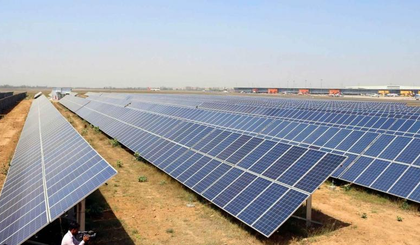Haryana aims to install 2.2 lakh rooftop solar systems by 2026-27
By IANS | Updated: August 7, 2025 17:14 IST2025-08-07T17:08:37+5:302025-08-07T17:14:54+5:30
Chandigarh, Aug 7 In a major push towards clean and sustainable energy, Haryana has set a target of ...

Haryana aims to install 2.2 lakh rooftop solar systems by 2026-27
Chandigarh, Aug 7 In a major push towards clean and sustainable energy, Haryana has set a target of installing 2.2 lakh rooftop solar systems under the PM Surya Ghar: Muft Bijli Yojana (PMSG: MBY) in 2026-27.
Reinforcing its leadership in green energy adoption, the state aims to solarise all government buildings by December 31, without availing any central financial assistance.
Surveys have already been conducted on 4,523 government buildings, identifying a cumulative solar potential of 122 MW.
The roadmap was unveiled on Thursday at the state-level coordination committee meeting chaired by Chief Secretary Anurag Rastogi, where senior officers presented the scheme's progress and outlined strategies for faster rollout.
"Haryana is not just promoting solar energy, we are ensuring it reaches the doorstep of every household, especially in rural areas," an official statement quoting the Chief Secretary said.
To make the switch to solar financially viable, the government is offering dual subsidies: Central financial assistance, which is directly transferred to consumers' bank accounts within 15 days of installation approval, and state financial assistance for 1 lakh Antyodaya families, provided on a first-come, first-served basis. Both subsidies significantly reduce the upfront cost of installation for economically weaker sections.
Additional Chief Secretary (Energy) A.K. Singh informed that as on date, 30,631 rooftop solar installations have been done in the state, and the state DISCOMs are working on bringing special booster schemes for accelerating such installations.
The combined incentives will provide sufficient financial aid for encouraging large-scale adoption among the middle and service class sections.
To inspire community-wide transformation, Haryana has also launched the Model Solar Village (MSV) initiative, under which one village in each district will be developed as a self-sufficient solar-powered hub.
Villages with a population of over 5,000 are eligible for Central financial assistance up to Rs 1 crore.
Balu village in Kaithal has already earned the distinction of becoming the state's first Model Solar Village, with selections underway in Karnal and Kurukshetra districts. These villages are being equipped with solar-powered streetlights, home lighting systems, water supply systems, and pumps, creating a round-the-clock green energy ecosystem.
To facilitate smooth implementation, Haryana's DISCOMs have developed an integrated online portal and have established over 280 helpdesks across subdivisions.
Capacity building has also been prioritised, with 703 DISCOM officials and vendors trained through programmes conducted by National Power Training Institute (NPTI) and the National Institute for Entrepreneurship and Small Business Development (NIESBUD).
Disclaimer: This post has been auto-published from an agency feed without any modifications to the text and has not been reviewed by an editor
Open in app